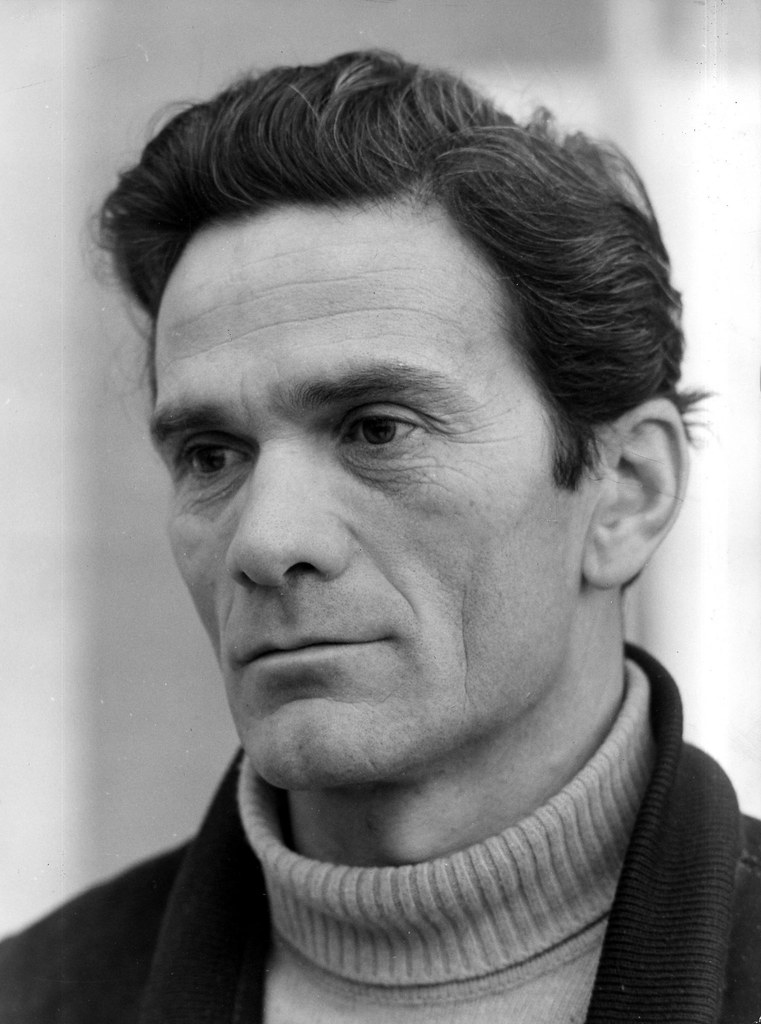1954-1972
Italy, United States
Writer, director, actor, painter and communist cultural worker, Pier Paolo Pasolini has been moving since the Sixties in a supranational and anticipated postmodern horizon; in his works, the close criticism of the post-war Italian society is accompanied by the attention towards the less industrialized countries, such as Eastern Europe, India (that he visited with Morante and Moravia in 1961) and the African continent. On the other side, the relationship with America is less obvious, and later. Only in the second half of the decade Pasolini has a direct contact with the US, during two trips in 1966 and 1969. The first one, undertaken to promote the release of his film The Hawks and the Sparrows, constitutes a particular reason of interest. For example, the enthusiastic statements made during an interview with Oriana Fallaci for L'Europeo ("Un Marxista a New York", October 13, 1966) were extremely surprising, since the writer was deeply impressed by the vitality of Americans and by the prospects of renewal that seemed to be opening up in that society, contrary to what was happening in the communist regimes in Eastern Europe.
Pasolini's interest in America was in fact especially political. As for literature, the writer openly declared that he did not appreciate the works of Faulkner, Hemingway and Steinbeck, points of reference for the previous Italian generation (above all, for Pavese and Vittorini), granting instead a greater consent to Eliot, Pound and Ginsberg, whom he met personally in 1966 (they met again in Milan, one year later). The effects of the 1969 trip, on the threshold of a period of crisis and political disillusion that would lead Pasolini to the reflection witnessed by the articles for Il Corriere della Sera and culminated in the novel Petrolio, are instead less striking.
However, by the mid-Sixties, his literary work had already begun to seep in the US, albeit in small proportion. A surprinsing incunabulum of that transfer is for sure the 1954 translation by William Weaver (then settled in Rome, like Pasolini himself) of the poem The Appennine (Folder 3), unpublished in volume in Italy and included in the collection Gramsci's Ashes only in 1957 (Le ceneri di Gramsci, Garzanti). While the diffusion of Pasolini's poems continued in the anthologies, and the distribution of his films begun (The Gospel According to St. Matthew was screened in the US theaters in 1965), the translation of his novels took a slower path. The first novel to appear in America is in fact The Ragazzi (Grove Press, 1968); in the same year, Weaver himself translated (but for an English publisher: Jonathan Cape) A Violent Life.
The slowness in the American translation of novels is perhaps partly due to the delay in publishing the Italian edition of the unfinished masterpiece Petrolio, that aroused a new interest in studying Pasolini when finally appeared, in 1992 (Einaudi). While this situation has in fact hindered the production of a US literature dedicated to his works, many essays on the writer have been published in recent years, and between 2012 and 2013 the MOMA has set up a complete retrospective on his film and painting production.
Related Vectors
Giulio Einaudi editore
publishing house
Oriana Fallaci
Journalist, writer
La Dolce Vita
film
The Literary Review
Literary magazine
Botteghe Oscure
Literary review
Chelsea
Literary Journal
Piero Poletto
Art director
Sources
Biancofiore, Angela. Pasolini. Palermo: Palumbo, 2003.
Chianese, Francesco. "Pasolini tra URSS e USA: L'intellettuale italiano negli anni della Guerra Fredda." Between 5, no. 10 (2015) [http://www.between-journal.it/].
Fallaci, Oriana. Viaggio in America. Milano: Rizzoli, 2014.
Ferraro, Alessandra, and Silvana Serafin. Pier Paolo Pasolini nelle Americhe. Udine: Forum, 2015.
Greene, Naomi. Pier Paolo Pasolini: Cinema as Heresy. Princeton: Princeton University Press, 1990.
Healey, Robin. Italian Literature since 1900 in English Translation: An Annotated Bibliography, 1929-2016. Toronto: University of Toronto Press, 2019.
Maggi, Armando. The Resurrection of the Body: Pier Paolo Pasolini from Saint Paul to Sade. Chicago: University of Chicago Press, 2009.
Pasolini, Pier Paolo. Lettere (1940-1954/1955-1975). Torino: Einaudi, 1986.
Schwartz, Barth David. Pasolini Requiem. 2 ed. Chicago: University of Chicago Press, 2017.
Siti, Walter. "Pier Paolo Pasolini." In Dizionario biografico degli italiani. Roma: Istituto della Enciclopedia Italiana, 2014.


